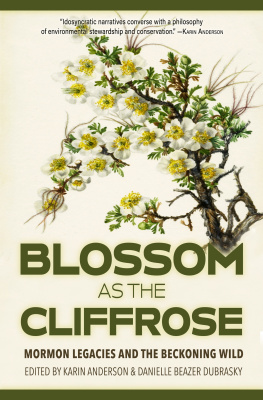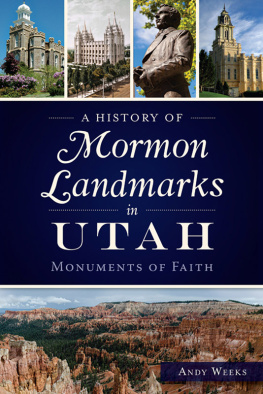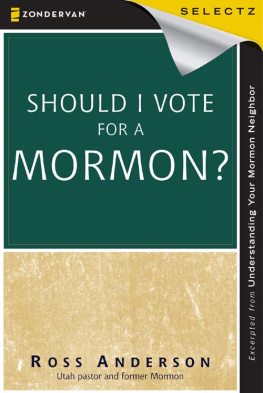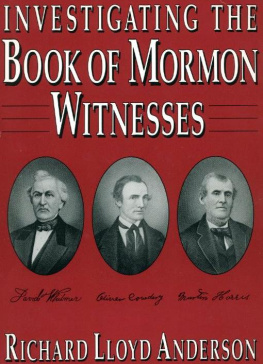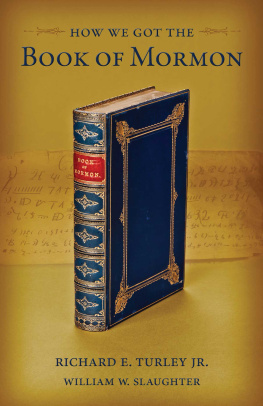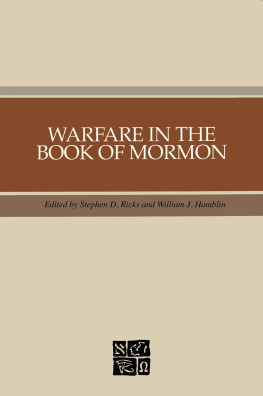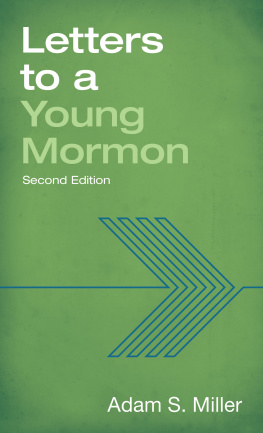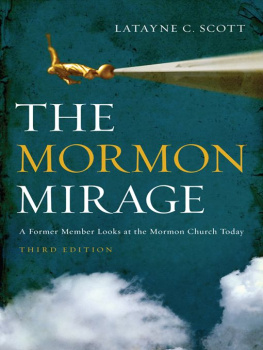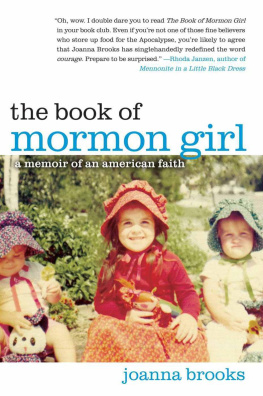Contents
Page List
Guide
PRAISE FOR BLOSSOM AS THE CLIFFROSE
No idea looms larger in the Mormon mind than wildernessa pure, unspoiled place that gives people refuge and prepares them for revelation. Blossom as the Cliffrose gathers some of Mormonisms most creative voices to testify to the power of wilderness spacesin the land, in our faith, and in our lives. The essays and poems in this volume come from the heart of the wilderness and are themselves both refuge and revelation.
Michael Austin, author of A Voice in the Wilderness: Conversations with Terry Tempest Williams and Vardis Fisher: A Mormon Novelist
When I ask my Mormon-Jewish daughter when she feels most Mormon, she tells me, When I am outside, in the canyons, in the mountains, in the West. The beloved community of writers assembled here articulates a thousand reasons why so many of us feel this way. These are rich and complicated feelingsnot just the sublimity of Wordsworths environmental imagination, but also feelings of betrayal, reverence, disappointment, pleasure, misunderstanding, and loss appropriate to a place storied with theft and massacre, failed dams and inland seas, uranium and abandoned poisons, dried seeps and sacred groves, salt and gulls, sego lilies, and hordes of crickets. Danielle Beazer Dubrasky and Karin Anderson are expert guides to this territory. Let them and this book bring you home.
Joanna Brooks, author of The Book of Mormon Girl and co-editor of Mormon Feminisms and Decolonizing Mormonism
I feel as if Ive just finished a trek in the desertburned by the illuminating sun of the Mormon mindset, parched by the thirst for certainty and hope both in nature and man, and made holy by the visions and insights one can only glean in the beauty of solitary, windswept places. These poems and essays dig into the caverns and canyons of a Mormon readers soul in ways that either comfort or disruptand sometimes both. Regardless of the effect, the themes are honest, piercing, and thought-provoking in every sense.
Tanya Mills, The Book Bungalow
BLOSSOM
AS THE
CLIFFROSE
BLOSSOM
AS THE
CLIFFROSE
MORMON LEGACIES AND THE BECKONING WILD
EDITED BY KARIN ANDERSON & DANIELLE BEAZER DUBRASKY
TORREY HOUSE PRESS
Salt Lake City Torrey
First Torrey House Press Edition, June 2021
Copyright 2021 by Karin Anderson & Danielle Beazer Dubrasky
All rights reserved. No part of this book may be reproduced or retransmitted in any form or by any means without the written consent of the publisher.
Published by Torrey House Press
Salt Lake City, Utah
www.torreyhouse.org
International Standard Book Number: 978-1-948814-42-3
E-book ISBN: 978-1-948814-43-0
Library of Congress Control Number: 2020946734
Cover art by Mary Vaux Walcott, Cliffrose (Cowania stanshuriana), 1934, Smithsonian American Art Museum
Cover design by Kathleen Metcalf
Interior design by Rachel Buck-Cockayne
Distributed to the trade by Consortium Book Sales and Distribution
Torrey House Press offices in Salt Lake City sit on the homelands of Ute, Goshute, Shoshone, and Paiute nations. Offices in Torrey are in homelands of Southern Paiute, Ute, and Navajo nations.
TABLE OF CONTENTS
Danielle Beazer Dubrasky
Tacey M. Atsitty
Phyllis Barber
Star Coulbrooke
Scott Cameron
Michael William Palmer
Laura Walker
Lee Ann Mortensen
Farina King
Darlene Young
Lyn McCarter
Matthew James Babcock
Jack Harrell
Dayna Patterson
Jennifer Champoux
Kathryn Knight Sonntag
Kimberly Johnson
George B. Handley
Lisa Madsen Rubilar
John Bennion
Natalie Young
Ronda Walker Weaver
Robert Terashima
Michael McLane
Stacie Denetsosie-Mitchell
Heather Holland
Nano Taggart
Laura Stott
Amelia England
Dayna Patterson
Lance Larsen
Twila Newey
Kathryn Cowles
Tamara Johnson
Reb Cuevas
Sarah Newcomb
Thomas W Murphy
Melody Newey Johnson
Reb Cuevas
Megan Fairbanks
Lisa Bickmore
Julie J. Nichols
Tyler Chadwick
Matthew Pockrus
David G. Pace
Theric Jepson
Jack Garcia
Danielle Beazer Dubrasky
Kumen Baldwin Louis
Christopher Nelson
Karin Anderson
PRELUDE
Danielle Beazer Dubrasky
LEAVE No TRACE
F IFTY MILES WEST OF FORT LARAMIE IN WYOMING, THE faint wagon wheel depressions left by Mormon emigrants have almost disappeared from the grasslands. The Mormon trek, both iconic and disruptive, evinces a people displaced from their established communities who would in turn enact further displacement on Indigenous peoples as part of a larger western narrative. But the Mormon narrative begins in a secluded grove of trees outside of Palmyra, New York, where Joseph Smith describes having seen a vision of deity in a pillar of light. As a person of faith I acknowledge that within the Mormon psyche, the interpretation of this encounter by Joseph Smith ranges a vast scale: from beacon of divine origin leading toward eternal salvation to fabrication or possible delusion with questionable merit. Leanings toward both ends of the spectrum have a place within this anthology. In the call for submissions, the co-editors stated: We use Mormon to name a cultural network and historical context that has, until recently, answered to this moniker since the early nineteenth century. We are interested in ways this tradition has engendered worldviews, habits, idiosyncratic histories, familial narratives, and variant communities. How do these aspects converse with a philosophy of environmental stewardship, protection, and conservation?
To grow up Mormon is to always be aware of pioneer footsteps that crossed the land before. Near Horseshoe Creek a steady wind blows over the grassy hills in a landscape that is open but secretive. Here on a hot day in late July, 1852, the Abraham O. Smoot Company stopped at the top of a steep hill to assess how the wagons and handcarts might descend. My ancestor Elizabeth Mainwaring stepped off the wagon and walked down the hill with her four-year-old son, Joshua, to the base thick with currant bushes. She told Joshua she was going to look for blackberries. She held a tin cup in her hands to give him a drink of water from a stream, then told him to return to the wagon at the top of the hill. That was the last time she was seen by anyone from the company with whom she had traveled along the pioneer trail since Kansas City, Missouri.

